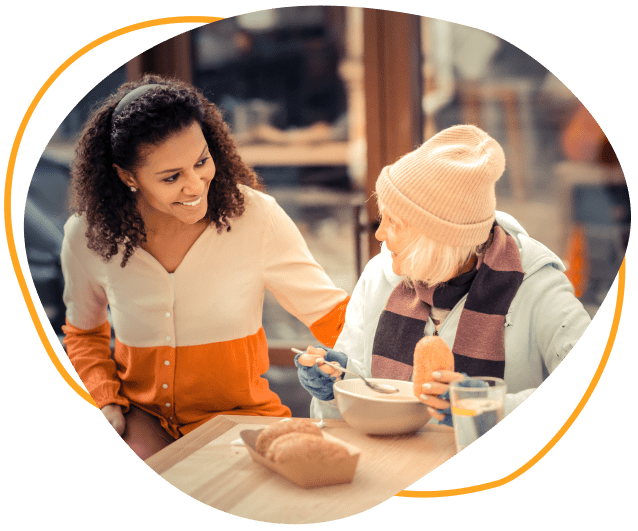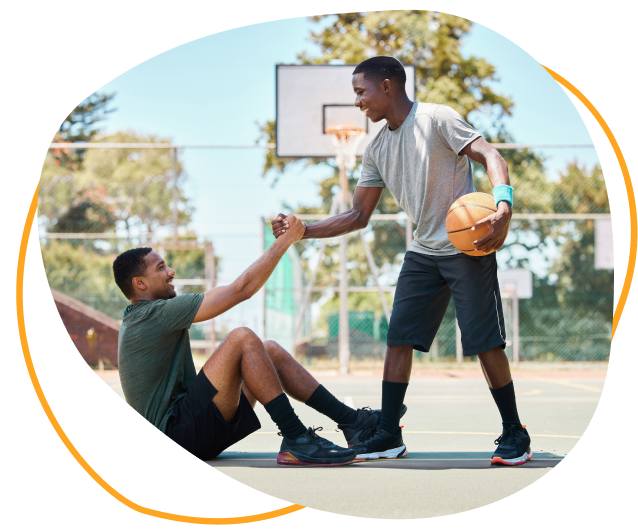WHITE PAPER
KINDNESS
& WELL-BEING
GO HAND IN HAND
From Sentiment to Science
WHITE PAPER
KINDNESS
& WELL-BEING
GO HAND IN HAND
From Sentiment to Science
In a world that sometimes feels harsh and lonely, kindness is gaining traction as a force for good.
Science confirms that acts of kindness boost physical, mental, and emotional well-being; they multiply in a circular and ever-expanding chain reaction.
Promoting kindness at work, and anywhere people interact, should be an essential element of comprehensive well-being strategies.
The “What” of Kindness
Kindness is hard to define precisely, but we recognize it in underlying acts and words of compassion, graciousness, and civility. This positive quality embodies caring, generous, and sometimes selfless behavior that reflects a desire to make life better.
- Lift others’ spirits
- Offer help or gifts
- Volunteer
- Express gratitude
- Accept others nonjudgmentally
- Lend a helping hand
- Listen mindfully

The “Who” of Kindness
Most acts of kindness involve at least 3 participants — and all stand to gain:
- Givers: Those who initiate
- Observers: Those who witness
- Receivers: Those to whom kindness is directed.
Your Receivers are commonly divided into 3 subtypes:
- People you know well — like friends, family, and coworkers
- The community — people you may not know
- Yourself — including self-kindness, self-care, or self-compassion.
Descriptions of Receivers will sound familiar to anyone who’s heard about strong and weak social ties or read the HES blog post, Social Connection: Beyond Besties. This is the perspective of researchers who conclude:
Kindness Is Prosocial
Psychologists describe kindness as prosocial behavior: voluntary actions primarily intended to improve the well-being of others — which:
- Includes a range of actions like sharing, comforting, rescuing, and helping
- Is driven by empathy, compassion, and a sense of moral responsibility
- Is essential to healthy relationships and societies.

Kindness Leads to Well-Being
When we act kindly as Givers, we take a step on the path to greater well-being, whether the Receiver is someone we know well, the community, or ourselves.
Kindness to People We Know
“Helping others makes you happy,” researchers find.2 “Practitioners are correct to see kindness interventions as effective ways of improving well-being.”
Being kind to people we know eases the emotional toll of stress3 and amplifies positive emotions (like happiness, joy, and pleasure) essential to personal flourishing.4
How Being Kind
Improves Health
Experts explain that acting kindly, and the stronger social connections that often follow, promote better health by:
- Affecting genes in white blood cells, which may lower the risk of heart disease, cancer, and neurologic disorders.5
- Kickstarting the brain’s reward systems to trigger feel-good biochemicals and reduce stress hormones, which ultimately decreases overall health risks.6

The American Psychiatric Association reports that simple acts of kindness — by buffering loneliness — may reduce stress as well as symptoms of depression and anxiety.
Kindness to the Community
Directing kindness to groups that include people we may not know — the community or society at large — yields huge dividends in well-being. Volunteer work, for example, promotes higher levels of:7
- Life satisfaction
- Happiness
- Self-esteem
- Sense of autonomy
- Physical and mental health.
The UK’s Mental Health Foundation advises, “Getting involved with a cause that is close to your heart can be hugely beneficial for both the cause and your own sense of well-being.”
Even acts of kindness to the environment, like reducing waste, planting trees, and conserving energy, protects the well-being of its current and future inhabitants. (To learn more, see the HES white paper, Healthier Planet, Healthier People.)
Self-Kindness
Like kindness to people we know and don’t know, kindness to ourselves is a vital, though less recognized, element of a flourishing life.
Research defines self-kindness as understanding and caring for ourselves — free of harsh self-criticism, especially during difficult times.
1
2
3
4
5
6
7
8
9
10
Self-kindness has been linked to many desirable outcomes8:
- Happiness, optimism, wisdom, personal initiative, and emotional intelligence
- Resilience, with advanced skills to cope with stress and bounce back
- Better relationships, characterized by empathy, altruism, and forgiveness
- Health behaviors like nutritious eating, not smoking, seeking appropriate medical care, and exercising.
Self-kindness, studies show, can become a habit: “One of the exciting aspects of self-compassion is that it is a skill that can be learned through targeted interventions…”9
In addition to its intrinsic benefits, self-kindness is a first step toward greater good. As we take care of ourselves, we build the fortitude to take care of others. The classic example, borrowed from airplane safety, effectively illustrates this relationship: You must secure your own oxygen mask before you can help others with theirs.
Observer Well-Being at a Glance
Most research linking kindness to well-being focuses on Givers: Act kindly and you’ll feel good. And, almost by definition, kindness is good for Receivers (though Givers tend to underestimate how much their kindness helps Receivers, whether they’re friends or strangers10).
Less predictably, science reveals that Observers, too, reap rewards.
Our brain, psychologist Rhett Diessner explains, draws upon our personal history to interpret acts of kindness we witness. We consequently experience them as if we’re both the Giver and Receiver, with similar outcomes due, researchers hypothesize, to physiological processes like those described for Givers. (See “How Kindness Improves Health.”)
When we think about, practice, and/or are beneficiaries of kindness, we’re more attuned to seeing it in our environment.
Recalling Kindness
Intriguingly, Observers benefit even if they don’t witness kindness in person. Psychologist Jonathan Haidt’s experiments show that recalling acts of kindness promotes prosocial behavior, validating a hypothesis he quotes from Thomas Jefferson11:
When any original act of charity or of gratitude, for instance, is presented either to our sight or imagination, we are deeply impressed with its beauty and feel a strong desire in ourselves of doing charitable and grateful acts also.
Experiencing Kind Media
Reading stories or watching videos about kindness also can elevate Observer well-being. In a healthcare waiting room, for example, visitors and staff who viewed kindness media felt happier, calmer, more grateful, and inspired compared to those watching commercial television.12 The intervention included videos that showed an act of kindness, connection, or caring, were uplifting, and/or reflected the universality of kindness. View a sample of kindness media.

Science Explains How Kindness Spreads
Receivers and Observers are motivated to act kindly to others, creating a virtuous cycle, where acts of kindness reinforce and amplify goodwill.
Several fields of science — dovetailing with explanations of how kindness enhances well-being — contribute explanations to what keeps kindness rolling.
Neurological
When we observe others performing a task, brain cells are stimulated as though we’re performing the task, helping us empathize, learn by watching, and connect socially.13
Seeing someone act kindly may activate these cells — called mirror neurons. In effect, according to theories based on this research, we adopt a kindness habit by observing kind behavior.
Social
When we receive an act of kindness, cultural norms motivate us to return the favor.14 Sometimes we reciprocate indirectly by “paying it forward” to a third party.
Further, we accept others’ acts of kindness as models for our own behavior. Kindness is expected, for example, in teams or communities that value it; acting kindly helps sustain our sense of belonging in the group.
Biochemical
Study subjects given a dose of synthetic oxytocin — a hormone that induces prosocial behavior — were 80% more generous than members of a control group given a placebo.15 Givers and Receivers — potentially even Observers — get a natural jolt of oxytocin levels from an act of kindness, creating a biochemical feedback loop that perpetuates kind behavior. The process may be complemented by the calming effect of serotonin, a neurotransmitter released when experiencing kindness.
Mirror neurons, social norms, and biochemicals only begin to help us understand how kindness flows and expands in a virtuous cycle. There’s still much we need to learn.
Kindness at Work
In a study of workplace kindness, Givers completed 5 acts of kindness to a personalized list of Receivers over 4 weeks; both were compared to a control group.16 “Receivers became happier after 2 months,” investigators reported, “and Givers became less depressed and more satisfied with their lives and jobs.”
What’s more, they confirmed that the virtuous cycle is sparked by coworkers: Receivers paid kindness forward with 278% more prosocial acts compared to controls.
Inc. magazine summarized how organizations can apply the study’s findings:
Encouraging acts of kindness in the workplace can create a virtuous cycle within teams that benefits everyone involved, especially the organization. When corporate values promote uninhibited kindness, it can lead to better work and positive outcomes. By starting with one random act of kindness, its effects can spread outwardly and have a significant impact.
Kindness also comes into play in talent acquisition: A survey of 18-29 year- olds, for example, found 77% were more likely to apply for a job posting that cited kindness as an organizational value.
9 Tips to Promote Kindness in Your Workplace
Give the virtuous cycle of kindness a whirl in your organization:
- Train managers to lead with kindness.
- Integrate kindness into the core elements of well-being strategies.
- Highlight acts of kindness in employee recognition programs.
- Stream kindness media in common areas, breakrooms, cafeterias, and/or trainings.
- Offer team-building activities that foster positive relationships and encourage kind interactions.
- Feature expertly crafted civility policies in employee handbooks.
- Use games and social events to encourage random acts of kindness among team members.
- Advocate for making sustainability a priority across teams, systems, and supply chains.
- Adopt kindness as a core organizational value, promoted in internal and external communications.
Employers that emphasize kindness create a more positive, productive, and successful environment where employees feel valued and motivated to contribute their best.
Conclusion
Kindness is more than just a feel-good sentiment — it’s a force that transforms individuals, workplaces, and communities. As this white paper illustrates, scientific evidence confirms the profound impact of kindness on physical, mental, and emotional well-being.
The virtuous cycle of kindness — where Givers, Receivers, and Observers all benefit — creates a current of positivity.
In an era where employee well-being and social connection are paramount, kindness can be a cost-effective, accessible, and powerful tool to nurture good — individually and collectively.
1 Rowland, L., Curry, O. S. (2019). A Range of Kindness Activities Boost Happiness. The Journal of Social Psychology, 159(3), 340-343.
2 Curry, O. S., Rowland, L. A., Van Lissa, C. J., Zlotowitz, S., McAlaney, J., Whitehouse, H. (2018). Happy to Help? A Systematic Review and Meta-Analysis of the Effects of Performing Acts of Kindness on the Well-Being of the Actor. Journal of Experimental Social Psychology, 76, 320-329.
3 Raposa, E. B., Laws, H. B., Ansell, E. B. (2016). Prosocial Behavior Mitigates the Negative Effects of Stress in Everyday Life. Clinical Psychological Science, 4(4), 691-698.
4 Nelson, S. K., Layous, K., Cole, S. W., Lyubomirsky, S. (2016). Do Unto Others or Treat Yourself? The Effects of Prosocial and Self-Focused Behavior on Psychological Flourishing. Emotion, 16(6), 850.
5 Nelson-Coffey, S. K., Fritz, M. M., Lyubomirsky, S., Cole, S. W. (2017). Kindness in the Blood: A Randomized Controlled Trial of the Gene Regulatory Impact of Prosocial Behavior. Psychoneuroendocrinology, 81, 8-13.
6 Fryburg, D. A. (2022). Kindness as a Stress Reduction-Health Promotion Intervention: A Review of the Psychobiology of Caring. American Journal of Lifestyle Medicine, 16(1), 89-100.
7 Thoits, P. A., Hewitt, L. N. (2001). Volunteer Work and Well-Being. Journal of Health and Social Behavior, 115-131.
8 Neff, K. D., Germer, C. K. (2013). A Pilot Study and Randomized Controlled Trial of the Mindful Self‐Compassion Program. Journal of Clinical Psychology, 69(1), 28-44.
9 Bluth, K., Neff, K. D. (2018). New Frontiers in Understanding the Benefits of Self-Compassion. Self and Identity, 17(6), 605-608.
10 Kumar, A., Epley, N. (2023). A Little Good Goes an Unexpectedly Long Way: Underestimating the Positive Impact of Kindness on Recipients. Journal of Experimental Psychology: General, 152(1), 236.
11 Algoe, S.B. Haidt, J. (2009). Witnessing Excellence in Action: The ‘Other-Praising’ Emotions of Elevation, Gratitude, and Admiration. Journal of Positive Psychology, 4(2), 105-127.
12 Fryburg, D. A., Ureles, S. D., Myrick, J. G., Carpentier, F. D., Oliver, M. B. (2021). Kindness Media Rapidly Inspires Viewers and Increases Happiness, Calm, Gratitude, and Generosity in a Healthcare Setting. Frontiers in Psychology, 11, 591942.
13 Iacoboni, M. (2009). Imitation, Empathy, and Mirror Neurons. Annual Review of Psychology, 60(1), 653-670.
14 Melamed, D., Simpson, B., Abernathy, J. (2020). The Robustness of Reciprocity: Experimental Evidence That Each Form of Reciprocity Is Robust to the Presence of Other Forms of Reciprocity. Science Advances, 6(23), eaba0504.
15 Zak, P. J., Stanton, A. A., Ahmadi, S. (2007). Oxytocin Increases Generosity in Humans. PLOS ONE, 2(11), e1128.
16 Chancellor, J., Margolis, S., Jacobs Bao, K., Lyubomirsky, S. (2018). Everyday Prosociality in the Workplace: The Reinforcing Benefits of Giving, Getting, and Glimpsing. Emotion, 18(4), 507-517.

